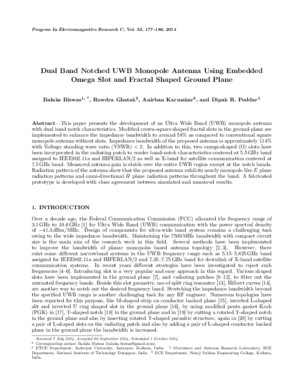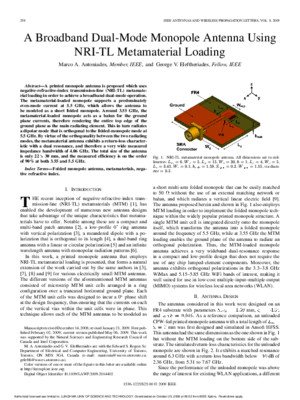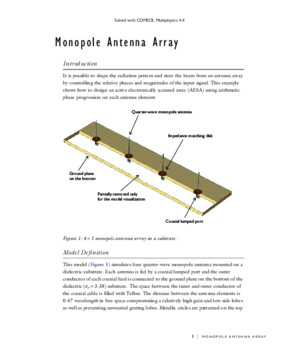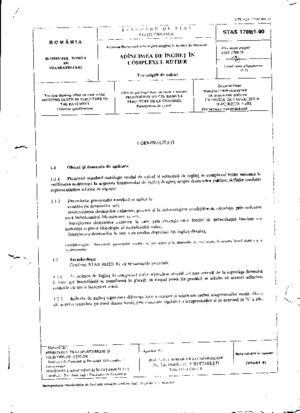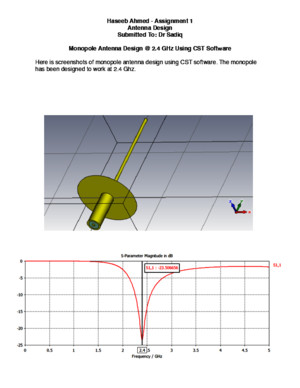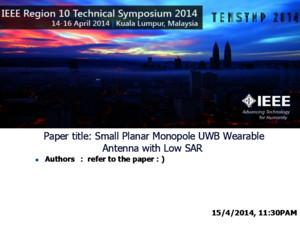13- 1714010805 Band-notched UWB Monopole Antenna
There is document - 13- 1714010805 Band-notched UWB Monopole Antenna available here for reading and downloading. Use the download button below or simple online reader.
The file extension - PDF and ranks to the Documents category.
Tags
Related
Comments
Log in to leave a message!
Description
Download 13- 1714010805 Band-notched UWB Monopole Antenna
Transcripts
Progress In Electromagnetics Research C, Vol 47, 147–155, 2014 Band-Notched UWB Monopole Antenna Design with Novel Feed forTaper Rectangular Radiating Patch Maryam Rahimi 1 , Ramezan Ali Sadeghzadeh 2 , Ferdows B Zarrabi 3, * ,and Zahra Mansouri 4 Abstract —In this paper, a novel dual notch bands Ultra Wide-Band (UWB) antenna for WLANand WiMAX applications is presented The antenna contains a taper rectangular monopole antennawith new feed line which is designed and modified for 2–12GHz To achieve notch band at WLANfrequencies, different methods are compared such as L-shape slots for one notch or dual rings in notchdesigning On the other hand, the novel F-shape feed line is designed to achieve dual notch bandcharacteristic The effects of stubs parameters at notch frequencies are presented The benefit of thisnovel feed line is designing multi-band and reconfigurable antenna by changing stub line parametersThe simulated results of prototype antenna are obtained with HFSS and CST Total size of the antennais 60mm × 60mm × 1 6mm It is fabricated on FR-4 low cost substrate and fed by 50Ω microstrip line 1 INTRODUCTION During the last decade, wireless communication systems have progressed too fast and become the mostimportant part in notebooks and cellular phones because of mobility and low cost [1,2] A WLAN linkstwo or more devices and provides a high speed connection through a wide-band internet access Recently,broadband systems are designed for faster communication and more data transfer [3,4] In 2002, theFederal Communication Commission (FCC) confirmed the frequency band from 31 to 106GHz forlow-power UWB applications [5]To prevent interference with existing wireless networks WLAN (515–5825GHz) and WiMAX(525–585GHz) according to IEEE 80211 standard the UWB antenna with a rejected band isdesirable [6] DCS (171–188GHz), PCS (175–187GHz), UMTS (192–217GHz) and 24GHz WLANare some frequencies used for wireless and personal communication, which are not in UWB frequencyranges Thus UWB antenna which covers these frequency bands is required One way to access suchstructures is to design multi-band antenna that operates at specific frequencies However, it is verydifficult to achieve such structures which support all these frequencies [2,7] IEEE 80211a standardconsiders 515–535GHz and 5725–5825GHz as send and receive bands, respectively IEEE 80211bgapplies 24GHz (24–2484GHz) to WLAN applications [8–10]Monopole antennas with microstrip feed line are widely used in designing UWB antenna becauseof low profile, low cost, light weight, easy fabrication, designing in desirable shape and integration withprinted circuit boards They also have UWB impedance matching (more than 100%) [11] Varioustypes of microstrip circular and elliptical patches have been considered CPW circular patches andtruncated ground plane are used for increasing the antenna impedance bandwidth [12–14] Nowadays Received 8 January 2014, Accepted 14 February 2014, Scheduled 20 February 2014 * Corresponding author: Ferdows B Zarrabi (ferdowszarrabiyahoocom) 1 Department of Electrical Engineering, Imam Khomeini International University, Qazvin, Iran 2 Ramezan Ali Sadeghzadeh ,Faculty of Electrical and Computer Engineering, KN Toosi University of Technology, Tehran, Iran 3 Faculty of Electrical andComputer Engineering, University of Tabriz, Tabriz, Iran 4 Department of Electrical engineering, Sciences and Research Branch,Islamic Azad University, Tehran, Iran 148 Rahimi et al slot antennas are a typical kind of UWB antenna [15,16] Various methods have been proposed forthe design of multi-band antennas The slots are the basic and conventional way for designing of notchband in UWB antennas So for this purpose, many slot shapes have been presented such as C, H, Uand L [17,18] In some researches, UWB monopole antenna with coplanar-waveguide (CPW) feed lineis presented, and notch frequencies are obtained by slots For having notch structure, slot is inserted inpatch, and the truncated ground plane is used for the improvement of impedance bandwidth [19,20]Other methods, such as parasitic strips and fractal structures, are conventional methods for designingmultiple band notch antennas on CPW or other UWB structures [21,22] Also many researches onapplying metamaterial and CRLH structures to design notch band in antenna have been reported [22–24]In this paper, a novel taper rectangular patch for UWB application is presented The effect of slotsmaking a notch band at WLAN and WiMAX frequencies is also shown At last, the novel F-shapefeed line for obtaining dual notch band is presented The feed line can be combined with conventionalslots and stub line for notch and reconfigurable multi-band application without using slot on antennaradiator 2 ANTENNA DESIGN21 Antenna Structure Figure 1 shows the proposed UWB antenna configuration The antenna consists of a rectangular groundplane and a taper rectangular patch which is implemented on the same side of the substrate The antennais excited by a microstrip line connected to patch through via with 1mm radius The microstrip line has3mm width which provides 50Ω input impedance A compact patch, with size 24 × 25mm, is achieved Figure 1 The proposed antenna configurationThe simulated and measured results are shown in Fig 2 The antenna has good VSWR in 22–11GHz The antenna is fabricated on a FR-4 low-cost substrate with relative permittivity of 44 andheight of 16mm Total size of the antenna is 45mm × 44mm × 1 6mm The distance of gap betweenpatch and ground is 05mmFigure 3 shows the efficiency of prototype UWB antenna, which lies between 60% and 92%, and inthis frequency range the antenna gain is 2–65dBi 3 BAND NOTCHED DESIGNS The goal of this paper is to design UWB antenna with dual-band rejection In order to generate dualband-notched characteristic, three different antennas are considered, and the effect of deformation isexamined For the first and second antennas by inserting slot on the patch, a notch band has beencreated For the third one by putting an F-shape stub next to the feed line, two notch bands areobtained Fig 4 shows the geometry and parameters of these antennas In the first antenna, radiating Progress In Electromagnetics Research C, Vol 47, 2014 149 Figure 2 Comparisons of VSWR among CST, HFSSand experimental result Figure 3 The simulated efficiency of UWBantenna in CST (a) (b) (c) Figure 4 Geometry of the notched-band antenna using (a) L-shape slots, (b) C-shape slots, (c) anF-shape stub connected to feed linepatch contains two L-shape slots with L 1 = L 2 = 10mm as shown in Fig 4(a) It causes a rejectionband between 5–6GHz which covers WLAN (515–535GHz and 5725–5825) In the second design,two parallel C-shape slots have been utilized for notch band at 4GHz, shown in Fig 4(b) The thirdantenna contains an F-shape stub which is added to microstrip feed line as shows in Fig 4(c) It causestwo rejection bands, at 25–32GHz and 5–6GHz for WLAN rejection 31 One Notch Antenna By adding two L-shape slots to UWB antenna, one notch band at 5–6GHz for eliminating interferencewith WLAN frequencies is obtained The effect of different lengths of L 2 on VSWR with constant L 1 is investigated L 2 affects the notch frequency of the antenna evidently As L 2 increases, the frequencyof notched-band decreases and notch bandwidth increases (see Fig 5) The notch band is placed at5–6GHz with L 2 = 7mm, and the antenna covers 23–49GHz for WLAN, Bluetooth, WiMAX and also6–106GHz for hyper LANFigure 5(b) shows simulated and measured results of the L-shape slot antenna The L-shape slotdimensions are L 1 = 10mm, L 2 = 8mm, and slot width is 2mmFigure 6 shows simulated efficiency of the prototype UWB antenna with L-shape slots, which lies
Recommended


